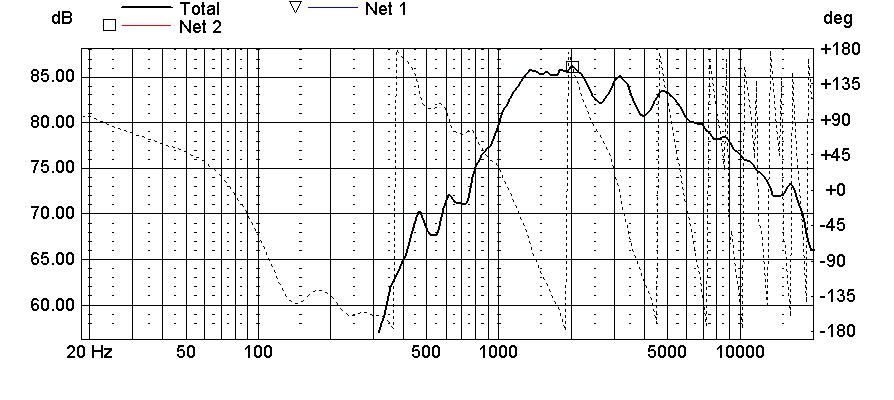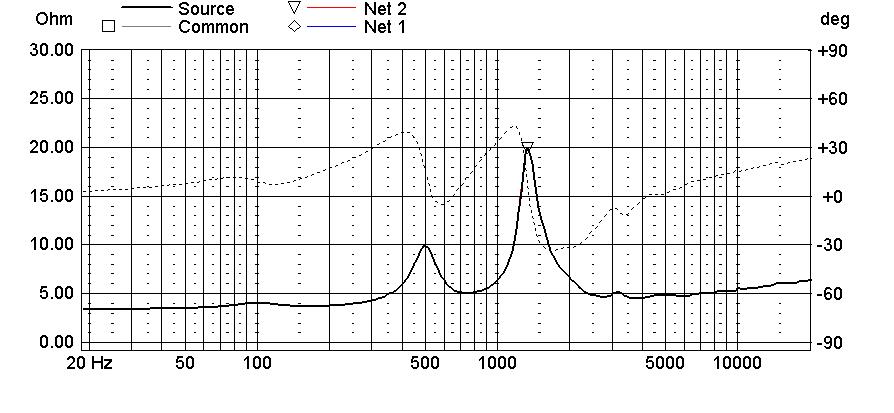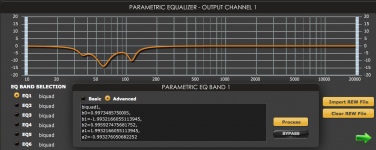Hi hollowboy. The test was done from my listening spot. I agree, graph looks a bit uneven. I spent around 4 hours listening to the lowthers, and wrote my comments after that. They are the most detailed realistic drivers I have heard. listening to the jbl after, they sounded thin and artificial. I am however always keen to get the best out of what I have, without having to do the extensive mod of adding a rear chamber, which I would have to construct through the hole cut of the 15”, as the cabs are completely sealed. If you could maybe advise on the crossover- I would like to restart this with a clean sheet, taking advise from those in the know, and see how good we can get them to sound. I will do a FR of the jbl, and of the lowther, and post by the weekend so you can see as well. So, where should we start on the crossover��
To design a proper crossover, you need to start with (semi)-anechoic measurements of the individual drivers in their respective enclosure(s)/horn, and ensuring a fixed 'time of flight' across all measurements.
Then, you'll realise that to achieve good phase overlap in the crossover region, you'll have to employ an asymmetric crossover, i.e., different slopes on the woofer(s) and the compression driver.
Then, you'll have to figure out how much attenuation you need on the compression driver, and how you want to implement that.
Then, you'll have to incorporate some degree of constant directivity equalization in the high-frequency branch of the crossover.
Then, ... ...
You get the idea. Obtaining good sound from a system using a horn-loaded compression driver is not a straightforward task.
If you feel overwhelmed or intimidated by all this, there are two possible ways forward: 1) be prepared to do a lot of studying; 2) go back to direct radiators, such as your Lowther.
BTW - have you ever listened to a pair of real Kinoshita monitors? They are amongst the best systems ever produced, regardless of price and typology, IMHO...
Then, you'll realise that to achieve good phase overlap in the crossover region, you'll have to employ an asymmetric crossover, i.e., different slopes on the woofer(s) and the compression driver.
Then, you'll have to figure out how much attenuation you need on the compression driver, and how you want to implement that.
Then, you'll have to incorporate some degree of constant directivity equalization in the high-frequency branch of the crossover.
Then, ... ...
You get the idea. Obtaining good sound from a system using a horn-loaded compression driver is not a straightforward task.
If you feel overwhelmed or intimidated by all this, there are two possible ways forward: 1) be prepared to do a lot of studying; 2) go back to direct radiators, such as your Lowther.
BTW - have you ever listened to a pair of real Kinoshita monitors? They are amongst the best systems ever produced, regardless of price and typology, IMHO...
Hi Marco. Thanks for that. I have heard that they are outstanding although I have not heard them in real life. Even though I only posted recently, I did the build in the latter part of last year. I have spent over 200 hours to get them to sound like they do now, but I know that I am way off the pace ie. I have done the wrong things to get it to sound better. I am using a minidsp to do active crossover, and thought maybe the guys with more practice and extensive knowledge would be able to impart some and help me redo that part completely. I can take screenshots and post as well of the minidsp settings. My problem is that I am inexperienced at reading the info off the graphs on REW.
I spent around 4 hours listening to the lowthers, and wrote my comments after that. They are the most detailed realistic drivers I have heard. listening to the jbl after, they sounded thin and artificial.
Did you compare the 2 drivers using the same DSP settings? If so, you'll be comparing two non-flat responses, and favouring the one that has more midrange / stronger vocals.
A better test would be to hook the L channel to configuration A (with crossover and eq set appropriately for A) and R channel to configuration B (with crossover and eq set appropriately for B), and then flip between them (with a mono signal).
I am however always keen to get the best out of what I have, without having to do the extensive mod of adding a rear chamber, which I would have to construct through the hole cut of the 15”, as the cabs are completely sealed.
IMO, you want to put a bigger, better horn there, not a Lowther 🙂
If you could maybe advise on the crossover- I would like to restart this with a clean sheet, taking advise from those in the know, and see how good we can get them to sound. I will do a FR of the jbl, and of the lowther, and post by the weekend so you can see as well. So, where should we start on the crossover��
a) Have you used the miniDSP eq functions yet (the screen that's pictured), or just the crossover function? Cos you should be able to get a better FR plot than you showed.
b) What HF horn are you using - is it the 2404H?
http://www.jblpro.com/pub/obsolete/2404.pdf
It looks about that size / configuration. Note that the spec sheet states a 3,000Hz minimum. Any horn that's substantially smaller than your 15" drivers is too small to cross at 900Hz.
So:
1st, try setting the crossover higher
2nd, apply some eq to flatten the response
3rd get a bigger & better horn
Attachments
To design a proper crossover, you need to
Maybe help him with the basics, then work up to all this?
Then, you'll have to incorporate some degree of constant directivity equalization in the high-frequency branch of the crossover.
I don't think the OP is using a constant directivity horn. It looks like a 2404H, which has a diffraction slot, and very wide polars like a dome tweeter.
Thanks hollow. My horn is the jbl 2342. Much a bit larger than the 2404. If I remember correctly, they stipulate a minimum crossover point of 800, but can’t find it now
Thanks hollow. My horn is the jbl 2342. Much a bit larger than the 2404. If I remember correctly, they stipulate a minimum crossover point of 800, but can’t find it now
The 2342 (229mm square) has:
"Crossover Frequency: 1.2 kHz Recommended"
http://www.jblproservice.com/pdf/Theatre Series/3678HF.pdf
The much bigger 2344 (320 mm square) has:
"Minimum Recommended Crossover Frequency: 800 Hz"
http://www.jblpro.com/pub/obsolete/2344.pdf
...so moving your crossover from 900Hz up to 1,200 Hz may help.
Morning hollow. Thanks for that. So what I will do today, is start a new profile on the minidsp. I will put hpf at 20hz and lpf at 1200, for the beyma, and hpf 1200 and lpf 20000 for the jbl. Will that do? What slopes should I use for each driver respectfully?
No, it won't "do"!
I've been trying to tell you before that it's not just a case of entering a couple of magic settings on your dsp. You need to stop navigating blind and read up on crossover theory. Get a book or two. Read it. Look up AES papers.
I'm always amazed by how much effort people are willing to put in building fancy cabinets and then refuse to educate themselves on crossover theory.
Or, just keep messing with your dsp till you tire of horns and conclude that your Lowther sounds better...
OK, sorry, I realise now I'm probably just coming across as a grumpy old pops... I'll just bow out.
I've been trying to tell you before that it's not just a case of entering a couple of magic settings on your dsp. You need to stop navigating blind and read up on crossover theory. Get a book or two. Read it. Look up AES papers.
I'm always amazed by how much effort people are willing to put in building fancy cabinets and then refuse to educate themselves on crossover theory.
Or, just keep messing with your dsp till you tire of horns and conclude that your Lowther sounds better...
OK, sorry, I realise now I'm probably just coming across as a grumpy old pops... I'll just bow out.
Brendan is a true businessman and I wonder what it would have been worth to him to outsource this crossover job so in the end everything sounds beautiful? I thought I'd make a joke, or may be not. Hey, I have an idea, 3% of monthly pay as one time reward to all the laborers who participated moving these 2 pieces of 200 kg each and one sponsor donation to diyAudio.
A crossover begins with the acoustic design which begins with the project requirements. Not requirements like power handling and such, but what the speaker really needs to do.
Horns and waveguides can be some of the best speakers around and it's a shame they aren't easy (unless you like a challenge 😉)
To reiterate an earlier point, you can't expect to successfully cross two ways by just adjusting filters until it sounds right. Sometimes there is no good way to do it. A good design tells you how to cross.
Horns and waveguides can be some of the best speakers around and it's a shame they aren't easy (unless you like a challenge 😉)
To reiterate an earlier point, you can't expect to successfully cross two ways by just adjusting filters until it sounds right. Sometimes there is no good way to do it. A good design tells you how to cross.
Brendan is a true businessman and I wonder what it would have been worth to him to outsource this crossover job so in the end everything sounds beautiful? I thought I'd make a joke, or may be not. Hey, I have an idea, 3% of monthly pay as one time reward to all the laborers who participated moving these 2 pieces of 200 kg each and one sponsor donation to diyAudio.
Hi Guys..Yes, I am a salesman😀. Not wanting to sound lazy, but I am still a noob at DIY. After last nights posts, I have spent about 6 hours researching points on crossover design. What I have done so far, and please correct me where need be:
1) taken the manufacturer driver specs, and assessed them
2) based on them, agreed with hollowboy on a 1200Hz cross point
3) put the initial data into the minidsp and played around with it.
This is where I need input:
I have the Beyma SM115 starting off at 30Hz with a 48db/oct LR slope. Role off at 1050Hz with a 18db/oct BW slope.
I have the JBL 2425 starting at 1400Hz with a 18db/oct BW slope and rolling of at 18000Hz with a 18db/oct BW slope.
This means that the drivers cross at 1200Hz at -6db, and rolloff at 20000 Hz at -6db.
Am I on the right track so far? Please advise
@AllenB, I have gone through your post, the first few pages, about 6 times as well, with notes, which was the most logical read for me so far. Thank you so much for that. The steps above, are based on your tutorial.
There are some differences. The cone breakup region is not ordinarily avoided with a horn system but needs to be negotiated to meet the directivity of the horn. This is complicated by the fact you are using multiple woofers. The complex measurements and power calculations are at an advanced level of crossover design.
The tweeter resonance is also largely irrelevant. It is mostly the qualities of the horn that dictate how and where it can be crossed. Unlike a conventional system, the overlap of possible crossover frequencies is not as relaxed and the decision would ideally be based on an initial matching of the ways.
The tweeter resonance is also largely irrelevant. It is mostly the qualities of the horn that dictate how and where it can be crossed. Unlike a conventional system, the overlap of possible crossover frequencies is not as relaxed and the decision would ideally be based on an initial matching of the ways.
SNIP <> SNIP Role off at 1050Hz with a 18db/oct BW slope.
I have the JBL 2425 starting at 1400Hz with a 18db/oct BW slope and rolling of at 18000Hz with a 18db/oct BW slope.
This means that the drivers cross at 1200Hz at -6db, and rolloff at 20000 Hz at -6db.
Am I on the right track so far? Please advise
Yes ( sort of ). There's more to it than simply picking a crossover point.
The 2425 on a 2342 biRadial horn needs HF compensation to ( essentially ) help flatten its response.
The un-compensated HF response ( of that driver on a 2342 ) will look something like this ( though this is a 2416H driver ) :
& the impedance of just the horn/driver combo will look something like this:
Are your JBL 2425 drivers the H or the J version ?
Since you have ( & can use ) REW, I suggest that you create your own frd & zma files using it.
The REW help file ( I believe ) can direct you on how to build a measuring jig so that you can make impedance measurements.
Once provided with those files, others ( including myself ) can quite easily publish an effective HF compensation network for you to build ( that'll help make that horn/driver combo sound listenable ).
🙂
Thanks for that Allen. Didn't quite grasp the first paragraph of your answer. The JBL horn that I am using, is recommended to use from 1200Hz, according to the spec sheet. This coincides with my crossover point as well.
Could you re-answer in more laymans terms. Sorry to be a pain.
And for the balance of my calcs, are they a fair starting point?
Could you re-answer in more laymans terms. Sorry to be a pain.
And for the balance of my calcs, are they a fair starting point?
Yes ( sort of ). There's more to it than simply picking a crossover point.
The 2425 on a 2342 biRadial horn needs HF compensation to ( essentially ) help flatten its response.
The un-compensated HF response ( of that driver on a 2342 ) will look something like this ( though this is a 2416H driver ) :

& the impedance of just the horn/driver combo will look something like this:

Are your JBL 2425 drivers the H or the J version ?
Since you have ( & can use ) REW, I suggest that you create your own frd & zma files using it.
The REW help file ( I believe ) can direct you on how to build a measuring jig so that you can make impedance measurements.
Once provided with those files, others ( including myself ) can quite easily publish an effective HF compensation network for you to build ( that'll help make that horn/driver combo sound listenable ).
🙂
Hi sir. Thank you for that. I must state, that I am not an expert on REW, however, am willing to give my best efforts in doing what you suggested. Anything that will help at this point. The more info and feedback I get, the more lost I am getting.
What should be my very first step in this process, so as to form a base on which to build?
Google "Impedance Measurement Jig"
Copy some of the pics to your hard-drive and then buy the parts to make up one of these test boxes.
In the meantime, create a measurement of your horn/driver combo ( no woofers ) from @ 1 Meter away , @ 20deg off the center axis of the horn.
Make it 30 to 40 db louder than the background noise in your room.
Zip the MDat file and then post it here.
🙂
Copy some of the pics to your hard-drive and then buy the parts to make up one of these test boxes.
In the meantime, create a measurement of your horn/driver combo ( no woofers ) from @ 1 Meter away , @ 20deg off the center axis of the horn.
Make it 30 to 40 db louder than the background noise in your room.
Zip the MDat file and then post it here.
🙂
Am I on the right track so far? Please advise
I am interested in how you got the FR plot you posted earlier to get so attenuated in HF region. Were the amplifier voltages the same for each driver? You should do FR measurements about 2 m from the baffle and on-axis (tweeter horn center) to get it started and later off-axis horizontally.
- Status
- Not open for further replies.
- Home
- Loudspeakers
- Multi-Way
- New "Kinoshita" type build
